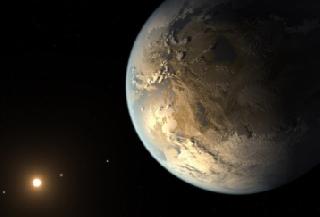
Kepler-186f (an artist's conception) is just 1.1 times the size of Earth. Photo: NASA.
WASHINGTON (AFP): The hunt for potential life in outer space has taken a step forward -- an international team of researchers has discovered the first Earth-sized planet within the "habitable zone" of another star.
The exoplanet dubbed Kepler-186f was first spotted by scientists using NASA's Kepler telescope, according to research published today in the US journal Science.
The exoplanet, located some 500 light years from Earth, orbits in what is seen as the sweet spot around its star: not too close and not too far, so it could have liquid water, considered a crucial component to possibly hosting life.
"The discovery of Kepler-186f is a significant step toward finding worlds like our planet Earth," said Paul Hertz, NASA's Astrophysics Division director at the agency's headquarters in Washington.
"What makes this finding particularly compelling is that this Earth-sized planet, one of five orbiting this star, which is cooler than the Sun, resides in a temperate region where water could exist in liquid form," said Elisa Quintana of the SETI Institute at NASA's Ames Research Center in California, the lead author of the paper published in Science.
Kepler-186f is around 1.1-times the size of Earth -- which researchers say is key to predicting the composition of the surface and its atmosphere.
When planets are 1.5 times the size of Earth or larger, many of them seem to attract a thick hydrogen and helium layer that makes them start to resemble gas giants like Jupiter or Saturn.
Kepler-186f is the fifth and outermost planet orbiting the Kepler-186 star, right on the far edge of that solar system's habitable zone, meaning the surface temperature might not be warm enough to stop water from freezing.
"However, it is also slightly larger than the Earth, and so the hope would be that this would result in a thicker atmosphere that would provide extra insulation," explained San Francisco State University astronomer Stephen Kane, another member of the team behind the discovery.
Scientists using the NASA's Kepler telescope first discovered it by tracking "transits" -- shadows that cross in front of the star.
The finding was confirmed by observations from the W M Keck and Gemini Observatories.
"The discovery of planets with Earth-like properties is one important link in the chain required to answer" whether life can exist on other planets, said co-author Fred Adams, an astronomer at the University of Michigan.
"And the discovery of the planet Kepler-186f is an important step toward finding a planet that is like our Earth," he added.
 Previous Article
Previous Article Next Article
Next Article












The Indian Air Force, in its flight trials evaluation report submitted before the Defence Ministry l..
view articleAn insight into the Medium Multi-Role Combat Aircraft competition...
view articleSky enthusiasts can now spot the International Space Station (ISS) commanded by Indian-American astr..
view article